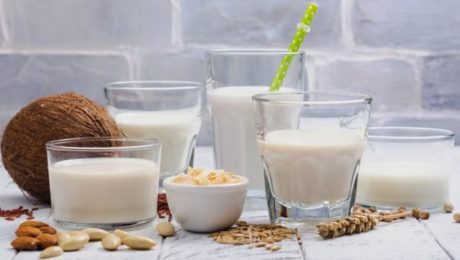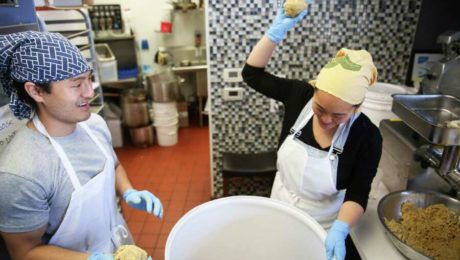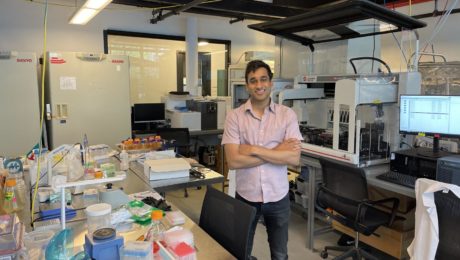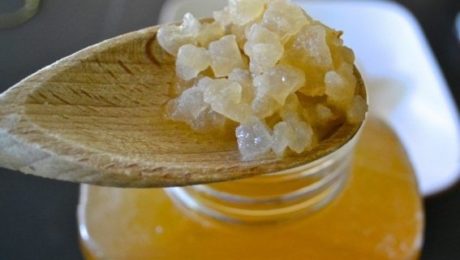Froyo’s Comeback
Frozen yogurt has been victim to trending food cycles for decades, first coming to America in the 80s, experiencing a boom in the 90s, then again in the early 2000s. Now industry leader say froyo is poised for its second (fourth?) act, thanks to the healthy ice cream alternative trend and wellness-focused product boom. And froyo this time around will be different.
“This trend will only grow stronger,” says Sam Yoon, president of froyo chain Yogurtland. Sales at Yogurtland were up 27% in 2021. “Frozen yogurt is healthier and contains probiotics that boost immune systems. Our frozen yogurt contains at least 10 million cultures at the time of manufacturing, and our flavors are developing around plant-based flavors our guests love, as well as sugar-free options.”
Plan for modern froyo shops to use high-quality ingredients, offer dairy-free options, highlight yogurt’s fermented and probiotic punch, utilize tech-driven self-service machines, partner with CPG brands and create diverse, global flavors.
“Millennials love the brand in New York, so we’ll keep playing to that,” Hershman adds. “For (Millennials), they grew up with frozen yogurt always being available, so to have a cool, clean kind of modern, sleek store to go to that sells frozen yogurt, versus kind of a dingy local shop, is a nice benefit,” says Neil Hershman, the largest franchisee of froyo shop 16 Handles.
Read more (QSR Magazine)
- Published in Food & Flavor
Chicago: A Fermentation Hub
If you still think of hot dogs and deep dish pizza as the icons of Chicago’s culinary scene, you need to think again. The so-called Capital of the Midwest is a hub of innovation in the food industry. Chicago has the largest food and beverage production in the U.S., with an annual output of $9.4 billion. Food startup companies in the region raised $723 million in venture capital last year.
“Chicago is one of the most diverse cities for eating,” says Anna Desai, Chicago-based influencer of Would You Like Something to Eat on Instagram. ”Our culinary scene is constantly elevating and evolving. We are always just a neighborhood or tollway away from experiencing a new culture and cuisine. I’m most excited when I find an under-the-radar spot or discover a maker who can pair flavors and ingredients that get you curious and wanting more.”
Desai started her blog in part because she wanted to champion the Asian American and Pacific Islanders (AAPI) community in the Chicago food and beverage scene. “Food has long served as a cultural crossroad,” she adds, and Chicago’s multicultural cuisine exemplifies that sentiment.
Chicago is home to some of the most creative minds in fermentation, from celebrity chefs, zero waste ventures, alternative protein corporations and the world’s largest commercial kefir producer. There are dozens of regional and artisanal producers lacto-fermenting vegetables, brewing kombucha and experimenting with microbes in food and drink.
“Chicago is a great food city in its own right, so naturally there is a ton of talent in the fermentation space,” says Sam Smithson, chef and culinary director of CultureBox, a Chicago-based fermentation subscription box. “The pandemic’s effect on restaurants has also spawned a new wave of fermenters (ourselves included) that are looking for a path outside the grueling and uncertain restaurant structure to display our creative efforts. This new wave is undoubtedly community-motivated and concerned more with mutual aid than competition. There is a general feeling that we are all working towards the same goal so cooperation and collaboration is soaring and we are seeing incredible food come from that.”
Flavor is King
Flavor development is still the prime motivation for chefs to experiment with fermentation. A good example is at Heritage Restaurant and Caviar Bar in Chicago’s Humboldt Park neighborhood.
“Fermentation has been a cornerstone of the restaurant since its inception,” says Tiffany Meikle, co-owner of Heritage with her husband, Guy. “With the diverse cuisines we pull from, both from Eastern and Central Europe and East Asia, we researched fermentation methodologies and histories, and started to ‘connect the dots’ of each culture’s fermentation and pickling backgrounds.”
Menus have included sourdough dark Russian rye bread, toasted caraway sauerkraut, kimchi made from apples, Korean pears and beets and a kimchi using pickled ramps (wild onions). Heritage has also expanded their fermentation program to the bar, where they’ve created homemade kombucha, roasted pineapple tepache, sweet pickled fruits for cocktail garnishes, and kimchi-infused bloody mary mix.
“It’s fascinating to me that there are so many ingredients you can use in a fermented product,” says Claire Ridge, co-founder of Luna Bay Booch, a Chicago-based alcoholic kombucha producer. “People are really experimenting with interesting ingredients in kombucha…I have seen brewers do some of the wildest recipes and some recipes that are very basic.”
Innovating Food
Chicago-based Lifeway Kefir is indicative of the innovation taking place in the city. Last year the company expanded into a new space: oat-based fermentation, launching a dairy-free, cultured oat milk with live and active probiotics.
“We’ve spent so many years laying the groundwork in fermented dairy,” says Julie Smolyansky, CEO. “Now we’re experimenting and expanding to see what’s over the next horizon, though we’ll always have kefir as our first love.”
Chicago is home for two inventive fermented alternative protein startups: Nature’s Fynd and Hyfé Foods. Both companies were born out of the desire to create alt foods without damaging the environmental.
“Conscious consumerism is a trend that’s driving many people to try alternative proteins, and it’s not hard to understand why,” says Debbie Yaver, chief scientific officer at Nature’s Fynd. The company uses fermentation technology to grow Fy, a nutritional fungi protein. “Fungi as a source of protein offer a shortcut through the food chain because they don’t require the acres of land or water needed to support plant growth or animal grazing, making fungi-based protein more efficient to produce than other options.”
Alternative foods outlasting the typical trend cycle is a challenge for companies like Nature’s Fynd. When grown at scale, Fy uses 99% less land, 99% less water and emits 94% fewer greenhouse gasses than raising beef. But, to make an impact, “we need more than just vegans and vegetarians to make changes in their diets,” Yaver adds.
Waste Not
Numerous companies are using fermentation as a means to eliminate waste. Hyfé Foods, another player in the alternative protein space, repurposes sugar water from food production to create a low-carb, protein-rich flour. Fermentation turns a waste product into mycelium flour, mycelium being the root network – or hyphae (hence the company name) — of mushrooms.
“[We’re] diverting input to the landfill and reducing greenhouse gas emissions at scale,” says Michelle Ruiz, founder. “Hyfé operates at the intersection of climate and health, enabling regional production of low cost, alternative protein that reduces carbon emissions and is decoupled from agriculture.”
Symmetry Wood is another Chicago upcycler. They convert SCOBY from kombucha into a material, Pyrus, that resembles exotic wood. Founder Gabe Tavas says Pyrus has been used to produce guitar picks, jewelry and veneers. Symmetry uses the discarded SCOBY from local kombucha brand Kombuchade.
Many area restaurants and culinary brands also use fermentation to preserve food for the long Chicago winters, when local produce isn’t available. Pop-up restaurant Andare, for example, incorporates fermentation into classic Italian dishes.
“Finding ways to utilize what would otherwise be waste products inspired our initial dive into fermentation. The goal is not just to use what’s leftover, but to make it into something delicious and unique,” says Mo Scariano, Andare’s CEO. “One of our first dishes employing koji fermentation was a summer squash stuffed cappellacci served with a butter sauce made from carrot juice fermented with arborio rice koji. Living in a place with a short grow season, preservation through fermentation allowed us access throughout the year to ingredients we only have fresh for a few weeks during the summer.”
Industry Challenges
Despite growing interest and increasing sales, fermenters face some significant hurdles.
Smithson at CultureBox says he sees that consumers are open to unorthodox, less traditional ferments. Though favorites like kombucha and sauerkraut dominate the market, “their share is being encroached on by increasingly more varied and niche ferments.” But getting these products to market can be a challenge. Small-scale, culinary producers are challenged by the regulatory hoops they need to jump through to legally sell ferments – especially unusual ones a food inspector doesn’t recognize.
“The added layer of city regulations on top of state requirements, sluggish health department responses, and inflexible policy chill the potential of small producers,” Smithson says. But he highlights the recently-passed Home-to-Market Act of Illinois as positive legislation helping startup fermenters.
Consumer awareness and education are also vital. “Many longstanding and harmful misconceptions on the safety and value of fermented products still exist,” Smithson says.
Matt Lancor, founder and CEO of Kombuchade makes consumer education a core part of marketing, to align kombucha as a recovery drink.
“Most mainstream kombuchas are marketed towards the yoga/crystal/candle crowd, and I saw a major opportunity to create and market a product for the mainstream athletic community,” he says. “We’re on a mission to educate athletes and the general public about these newly discovered organs [the gut] – our second brain – and fuel the next generation of American athletes with thirst quenching, probiotic rich beverages.”
Product packaging provides much of a consumer’s education. Jack Joseph, founder and CEO of Komunity Kombucha, says simplicity is key.
“People are more conscious of their health now, more than ever before,” he says. “So now it comes down to the education of the product and creating something that is transparent and easy for the consumer to digest.”
Sebastian Vargo of Chicago-based Vargo Brother Ferments agrees.
“Oftentimes food is considered ‘safe’ due to lack of microbes and how sterile it is,” he says. “Fermentation eschews the traditional sense of what makes food ‘safe’. We need to create a set standardized guide for fermented food to follow, and change our view of living foods in general. One of the brightest spots to me is the fact that fermentation is really hitting its stride and finding its place in the modern world, and I don’t see it going anywhere but up in the near future.”
- Published in Business, Food & Flavor
The Microbiome “Black Box”
The gut microbiome is the “black box” of nutrition research, according to the new study “Rethinking Healthy Eating in Light of the Gut Microbiome.” We will never fully understand the science behind nutrition without understanding the bacteria living in the gut.
“Given the worldwide epidemic of diet-related chronic diseases, evidence-based dietary recommendations are fundamentally important for health promotion,” reads the study. “Despite the importance of the human gut microbiota for the physiological effects of diet and chronic disease etiology, national dietary guidelines around the world are just beginning to capitalize on scientific breakthroughs in the microbiome field.”
The study, published in the journal Cell, Host & Microbe, was conducted by researchers and scientists from Canada’s Department of Agriculture, Food & Nutritional Science; Ireland’s University of College Cork Centre for Vitamin D and Nutrition Research; and the APC Microbiome Ireland. It discusses “contemporary nutritional recommendations from a microbiome science perspective, focusing on mechanistic evidence that established host-microbe interactions as mediators of the physiological effects of diet.”
Though research on the microbiome and gut health has increased in the last decade, “there has been limited consideration of diet-microbiome-host interactions.” Researchers propose an “experimental framework that integrates the microbiome into nutrition research.”
Below are some of the challenges researchers found in creating a microbiome-focused diet.
More Fermented Food Research
Fermented foods are an excellent approach for microbiome restoration, the study notes. In individuals who have a diet rich in fermented foods, the organisms from the fermented foods are well-represented in their microbiota.
But more research is needed on fermented foods – especially non-dairy ones. Published studies link fermented foods to more favorable gastrointestinal health, lower risk of type 2 diabetes and cancer, increased microbiome diversity and weight management.
“Evidence from random control trials is extremely sparse, and fermented foods are just beginning to be recommended in dietary guidelines,” the study notes.
Lacking Dietary Guidelines
The study details different countries’ food recommendations and healthy eating guidelines in relation to the gut microbiome. Interestingly, though the regions have diverse food cultures, similarities were found: vegetables, fruit and grains should make up half a diet; whole grains should be prioritized over refined grains; animal protein and plant-based proteins should be consumed in small portions; foods high in sugar, salt and saturated fat should be limited or avoided.
But only one country – South Africa – mentions the gut microbiome.
Personalized Nutrition
Still, dietary guidelines are not a one-size-fits-all approach. There’s a greater need for personalized nutrition (also referred to as precision nutrition) because the gut microbiota is highly individualized. National dietary guidelines currently do not consider personalized nutrition.
As technology improves and microbiome sequencing increases, it’s possible a smart phone app could help the public monitor their diets, with recommendations personalized to their needs.
“Precision-nutrition approaches will depend on continued collaboration between nutrition and microbiome disciplines, and their population-wide implementation will require significant additional input from regulatory bodies, professional societies, and policymakers,” the study says.
Unknowns of Fermented Plant-Based Protein
There are “promising findings” regarding plant-based proteins’ interaction with the microbiome. Because these products are less digestible than animal-based proteins, they produce beneficial metabolites in the gut. However, the study points out more research is needed into these fermented alternative proteins that are fueling current innovation in alt meats.
Ancestral vs. Industrialized Diets
Modern diets – also known as industrialized diets – are far from those of our hunter-gatherer ancestors. Ancestral diets included more plants, higher dietary fiber and fewer refined carbs and sugar. The chronic disease epidemic, researchers note, can be attributed to modern diets being “evolutionarily mismatched with human physiology.”
“Evolutionary considerations also lay the foundation for microbiome restoration strategies,” the study continues. “Although it will likely be impossible, and perhaps not advisable, to return microbiomes to their ancestral states, there is heightened interest in the development of microbiome restoration strategies that re-establish health-related functional characteristics.
Turning Brewery Waste Into Milk
Brewing giants Molson Coors and Anheuser-Busch are introducing new brands into the growing alternative milk category.. The brewers’ non-alcoholic, plant-based barley milks are “pioneers of a nascent sub-category in the fast-growing alternative milk field, with each product utilizing byproducts of their main business,” according to Ad Age.
Barley milk, notes the article, is a smart product that helps the brewers diversify their product portfolios. buoys declining beer sales, capitalizes on the growing wellness trend and upcycles a brewing byproduct.
Both brands (Molson Coors calls their barley milk Golden Wing; Anheuser-Busch, Take Two) are in the trial stage and aiming to raise awareness. Golden Wing is currently sold only in Southern California, and Take Two is only in the Pacific Northwest.
Take Two is positioned as an eco-friendly beverage, and is working with advocacy groups like the Upcycled Food Association. Anheuser-Busch produces about 8 billion pounds of spent barley a year.
“All that’s been removed is the sugar and starch. All this wonderful protein and fiber is still there,” says Holly Feather, head of marketing for Anheuser-Busch. She notes much of that spent grain is sent to commercial farms. “Saving the planet doesn’t have to be so serious. You can have a good time and do something good in the mix.”
Golden Milk, on the other hand, is aiming to be the “badass” alt milk alternative, and is marketing to health-conscious men.
“We want to invoke curiosity in consumers when they see our packaging and our bold voice, and ultimately get them to try our great-tasting products,” says Brian Schmidt, marketing manager for Molson Coors. “Longer-term, we want Golden Wing to unlock barley milk as the next big thing in the plant-based milk category, and we believe it can do just that.”
Read more (Ad Age)
- Published in Business
Scaling Artisanal Fermentation
Fungi fermenter Shared Cultures was the featured cover story in a recent Food & Wine section of the San Francisco Chronicle. Company co-owners Elena Hsu and Kevin Gondo make small-batch fermented soy sauce, miso, and sauces and marinades using koji and wild, foraged mushrooms.
The article calls Shared Cultures “the darling of the Bay Area food scene.” It details how they use traditional techniques with unexpected ingredients, like a shoyu with quinoa and lentils, a miso with cacao nib and a koji salt with leek flowers.
Hsu and Gondo also open up about the challenges of scaling artisanal fermentation. They are the only employees at the companys and can’t keep up with the demand. Their ferments require a lot of time, some fermenting for eight months in a closet-size room in their rented commercial kitchen. They note that it is too expensive to rent or purchase their own warehouse in the Bay Area.
Multiple California chefs use Shared Cultures products for an added umami punch. Hsu encourages home cooks to experiment with their products, too, “You don’t have to have a $300 tasting menu to try these flavors,” she says. “You can be the chef.”
Read more (San Francisco Chronicle)
- Published in Business, Food & Flavor
Do Alt Protein Brands Tarnish Food Shows?
Does allowing alternative protein or bio-tech brands into Natural Products Expo West distort the natural foods industry? An article in Forbes argues that the show producers’ decision to allow lab-created, animal-free products into this year’s event is “troubling,” “confusing” and “harmful.”
Expo West has long been the “it” show for established and startup companies in the natural and organic products industry. Forbes says allowing an alternative dairy brand to exhibit next to a legitimate plant-based product that uses organic ingredients is hurting higher-quality brands, “especially when biotech brands are claiming to be superior to plant-based, even as they attempt to co-opt plant-based messaging, as some do.”
Read more (Forbes)
- Published in Business
Microbial Farmers
An article in Modern Farmer highlights “the new generation of microbial farmers,” scientists using microbes to replace chemical additives in food.
At Kingdom Supercultures, co-founders Ravi Sheth (pictured) and Kendall Dabaghi have developed natural microbial strains that mimic additives “instead of having a library of artificial chemicals.” Scientists at the company use machine learning to explore millions of “uncharacterized microbes that live inside fermented food. They extract microbial strains, merge them with other isolates and design what they call ‘supercultures.’”
The end results are healthier compounds with flavors, textures and functional properties similar to their artificial – and less healthy – counterparts. Since the company launched in 2020, they’ve made additives for plant-based cheese and yogurt, vegan personal care products and a vegan butter exclusive to Eleven Madison Park restaurant in New York.
Read more (Modern Farmer)
- Published in Business
Study: What Bacteria Survive Digestion?
New research has explored how lactic acid bacteria (LAB) in sauerkraut and tibicos survive digestion and change gut microbiota composition.
This work, published in Frontiers in Microbiology, investigated how a fermentation production process affects LAB and yeast microbial viability and probiotic potential. Though there are studies that demonstrate health benefits of fermented foods, few “explore how being part of a whole fermented food matrix affects microbial viability during fermentation, storage and gastrointestinal (GI) transit.”
The study focused on non-dairy, botanical fermented foods, defined as “microbially transformed plant products rich in health-promoting components.” Tibicos and sauerkraut were chosen because recent research had found the microbial diversity of the two ferments “far exceeded that of dairy-based ferments, as well as containing the largest numbers of potential health-promoting gene clusters.” The tibicos studied was sugar-based while the sauerkraut was brine-based, and both contained various strains of LAB and bioactive components.
Ginger, cayenne pepper and turmeric added to tibicos were all found to have different survival rates in the digestion tract. These functional spices are often added to fermented products for their anti-inflammatory and sensory properties, but their microbial proliferation had never been adequately explored. Cayenne was the clear winner, as adding it to tibicos “significantly improved the survival rate of LAB during simulated gastric and small intestinal digestion compared to ginger and turmeric.” Ginger in tibicos had a higher rate of LAB survival than turmeric, though neither had a significantly higher LAB survival rate than plain tibicos. But adding ginger significantly increased and sustained microbial viability of LAB.
The research team — from University of Melbourne — did not perform the study on human subjects, but simulated upper gastrointestinal digestion and colonic fermentation tests using pig feces.
Some other significant findings:
- For an optimal microbial survival rate of 70-80%, tibicos should be consumed within 28 days, and sauerkraut within 7 weeks.
- Sauerkraut made with different salt concentrations did not show any significant variation in LAB counts.
- Inoculating sauerkraut with a starter culture increased LAB counts during fermentation and storage. But, by the end of storage, the LAB counts in the inoculated sauerkraut “dropped to undetectable levels.”
- Spontaneously-fermented sauerkraut LAB counts remained stable through the storage period.
“Botanical fermented foods are cheap, easily made, and consumed globally,” the study concluded. “This makes them excellent candidates for the dietary management of pro-inflammatory noncommunicable diseases, such as type 2 diabetes and metabolic syndrome.
Jewish Delis GoVegan
Jewish delis are evolving for modern consumers, offering plant-based alternatives to lox and pastrami.
“We’re literally saving the Jewish deli. We’re giving it the modern twist that’s desperately needed to stay delicious and relevant to a growing segment of the population,” said Jenny Goldfarb, the founder and CEO of Unreal Deli. Goldfarb’s plant-based corned-beef-pastrami hybrid attracted an investment deal on SharkTank, and today it’s available in 2,200 grocery stores.
Though Jewish cuisine is known for being heavy on meat, vegetarian food has a part in Ashkenazi culture, notes Jeremy Umansky, chef at Larder Deli in Cleveland. He points out that kashruth (kosher dietary laws) and periods of poverty meant Jewish cuisine always included vegetarian recipes.
The food at Larder — which includes vegan and vegetarian dishes — is put through the same process as animal-based items. Umansky cures mushrooms with salt and koji for a smoky, savory flavor and meat-like texture.
“It’s all about the method and technique behind the production of those foods,” Umansky said. “You know, going back and looking at things and seeing that there is historical precedent for this.” Pictured, a selection of vegan Jewish deli fare at Ben & Esther’s in Portland, Oregon.
Read more (Insider)
- Published in Business, Food & Flavor
Expo West Returns
In March 2020, Natural Products Expo West became one of the first casualties in the U.S. events world, shut down by the outbreak of Covid-19 even as booths were being set up in Anaheim. Now, two years later, Expo West returns to Orange County with natural food exhibitors from around the world. TFA staff and advisory board members will also be in attendance.
In 2019, the enormous spring trade show attracted around 88,000 registrations; this year, that number is estimated at 55,000-60,000. Show producer New Hope Network (part of London-based Informa PLC) is also including a virtual option for attendees still unable or unwilling to travel.
The trends at this year’s event are being driven by Millennial and Gen Z consumers. New Hope put a spotlight on six top themes in a recent webinar:
No. 1: Functional Ingredients. “Health and wellness products make up a quarter of the volume of the industry but represent two-thirds of all growth,” said SPINS Data Analyst Scott Dicker. “We’re seeing consumers pushing for individual pursuit of wellness across channels.”
No. 2: Organic & Regenerative. Food that focuses on performance nutrition, food made with ashwagandha or food with paleo ingredients are driving growth for organic and regenerative products. Sodas and carbonated beverages are also helping organic products grow, “one of the last ‘junk food’ categories penetrated by natural and organic,” Dicker said. Gut health sodas, especially.
No. 3: Climate and Sustainability. Media headlines are declaring carbon as the new calorie. Consumer surveys speak to that — 70% will pay more for “premium, sustainable, climate-friendly products” and 80% want brands to educate them on their roles in climate issues. Companies are changing ingredient sources and product packaging to be more environmentally-friendly.
No. 4: Diversity. “Over the past couple years, we’ve seen tremendous growth in women, minority, NGLCC (National LGBT Chamber of Commerce) certified and veteran-owned businesses and you’re going to see it all over the show floor,” Dicker said.
No. 5: Plant-Based Innovation. Plant-based eating has skyrocketed over the last five years. “But plant-based alone isn’t enough anymore. What are plant-based brands doing to keep up with innovation?” Dicker said.
No. 6: Sustainable Meat & Dairy. Though the sustainable meat and dairy category is down 2.1%, pockets of it are growing, specifically grass-fed, fair trade and animal welfare and sustainability claims. Innovations are coming from small and local farms.
Read more (New Hope Network)
- Published in Business, Food & Flavor










